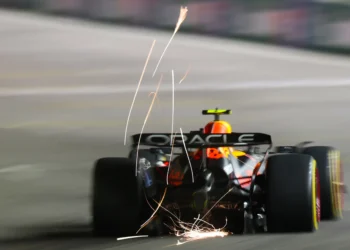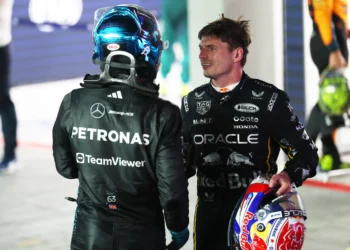Title: Dramatic Rescue: George Russell’s Near-Miss with Fire at Brazilian Grand Prix!
In a heart-stopping moment captured on social media, Mercedes F1 star George Russell narrowly avoided a potentially catastrophic fire incident, thanks to the quick actions of Alpine mechanics during the Brazilian Grand Prix. The spectacle unfolded last weekend at the iconic Interlagos circuit, where the excitement escalated as the F1 championship raced into the penultimate sprint of the season.
As the 21st round of the 2025 campaign unfolded, tension was palpable. Russell, finishing a disappointing sixth in the first practice session, returned to the pits, only to find himself in a precarious situation. Video footage shows the 27-year-old pointing urgently at the front brakes of his W16, a gesture that would soon prove crucial. Swiftly, the attentive Alpine team members sprang into action, deploying their cold air guns to combat the overheating brakes—a move that could have averted disaster.
The moment was charged with adrenaline as Russell, visibly relieved, gave a thumbs-up to the rival team’s mechanics. Over the team radio, instructions were swiftly conveyed for him to execute a practice pit stop and shut down the car once he regained control. Observers on social media noted the growing camaraderie between Alpine and Mercedes, sparking speculation that this collaboration might be linked to Alpine’s recent multi-year agreement to utilize Mercedes power units starting in 2026. One user provocatively quipped, “They are training for 2026,” while another questioned, “What wouldn’t they do for their future engines?”
However, let’s not overlook the urgency of the moment. Any pit crew, regardless of rivalry, would have responded similarly when faced with the imminent threat of a fire due to the brakes overheating. The reality is that Russell was fortunate to have the Alpine mechanics nearby, ready to blow cool air onto his car—a critical intervention that could have saved his vehicle from a fiery fate.
So, how do F1 cars find themselves at risk of bursting into flames? The answer lies in the extreme temperatures generated by the braking systems, particularly just before the car comes to a stop—a process that often creates a build-up of heat with insufficient airflow to cool the components. The potential for disaster looms at these moments, as Mercedes reports that their brake discs can reach scorching temperatures of over 1,000 degrees Celsius.
This harrowing incident not only highlights the dangers inherent in Formula 1 racing but also serves as a testament to the quick-thinking and professionalism of the Alpine mechanics. As fans and teams alike hold their breath in anticipation of the next race, one thing is clear: the world of F1 is as thrilling and unpredictable as ever!










